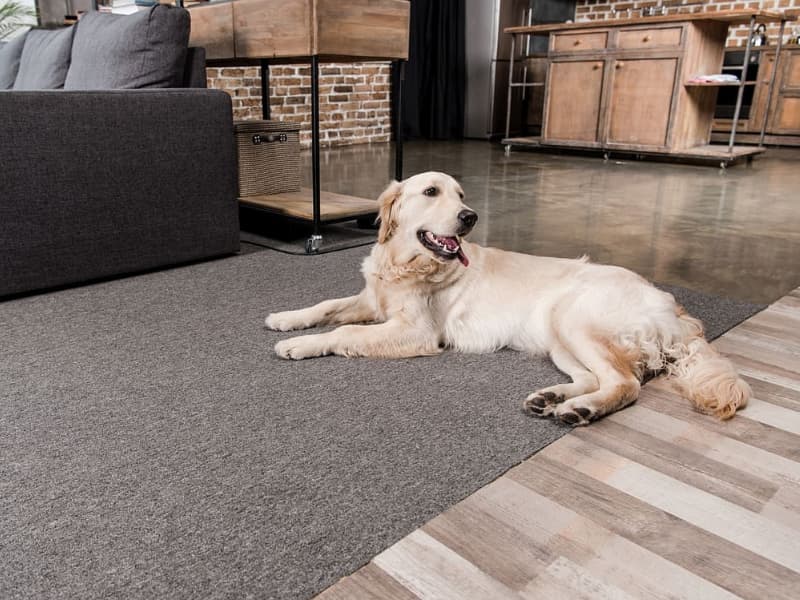Have you ever watched your furry friend gingerly tiptoe across your gleaming hardwood floors, their paws seemingly stuck to the surface? Their cautious steps and hesitant gait might seem comical, but for your pup, it’s a real source of discomfort. This isn’t just about a preference for plush carpets—there are actual reasons why your dog may dislike walking on hardwood floors.

Image: animalia-life.club
Understanding these reasons is essential to helping your beloved companion navigate the world comfortably. Just like humans have preferences for different surfaces to walk on, so do dogs. This article will delve into the most common reasons why your dog might be hesitant to walk on hardwood floors, offering valuable insights and practical tips to create a more enjoyable environment for your furry friend.
The Science of Slippery Surfaces: A Dog’s Perspective
Hardwood floors pose a unique challenge for dogs, primarily due to their inherent slipperiness. While we might find walking on hardwood a pleasant experience, for dogs, it’s anything but. Their paws, designed to grip rough terrain, struggle to find traction on smooth, polished surfaces. This lack of grip can lead to a variety of issues, including:
1. Slipping and Sliding: A Recipe for Pain and Fear
Imagine trying to walk on ice – that’s what walking on hardwood can feel like for a dog. The lack of traction can cause them to slip and slide, potentially leading to falls and injuries. These experiences, while seemingly minor to us, can be terrifying for dogs, leading to fear and apprehension when they encounter hardwood floors.
2. Sore Muscles and Joints: The Price of Unbalanced Gait
To compensate for the lack of grip, dogs often adjust their gait, shifting their weight and taking uneven steps. This unnatural movement pattern can strain their muscles and joints, causing pain and discomfort, especially in older dogs or those with pre-existing conditions.

Image: floorsum.com
3. Fear of the Unknown: Anxious Paw Prints
The sensation of slipping and the fear of falling can create a negative association with hardwood floors in dogs. This fear can manifest as avoidance behavior, where they refuse to walk on the surface or even show signs of anxiety when approaching it.
Beyond Slipperiness: Other Factors Contributing to Canine Discomfort
While slipperiness is a major factor, other reasons might contribute to your dog’s reluctance to walk on hardwood floors.
4. Cold Floors: A Chilling Experience
Dogs feel temperature differences more intensely than humans, especially on their paws. Walking on cold hardwood floors can be a chilling experience, particularly during colder months. This can be a major reason for their discomfort, as they may perceive the coldness as unpleasant or even painful.
5. Noise and Echo: A Symphony of Discomfort
Hardwood floors are notorious for amplifying sounds, creating a noisy environment that can be overwhelming for sensitive dogs. The sound of their own paws tapping on the floor can be amplified, making them feel vulnerable and anxious, especially in quiet or unfamiliar environments.
6. Foot Sensitivity: A Paw-sitive Need for Comfort
Just like we have sensitive skin, dogs can experience sensitivity on their paw pads, which are prone to dryness, cracks, or allergies. Walking on hard, unforgiving surfaces like hardwood floors can irritate these sensitive areas, making the experience uncomfortable.
Creating a Dog-Friendly Home: Tips for a Happy Paw-sitive Experience
The good news is that you can make your home more dog-friendly, even if you have hardwood floors. Here are some easy steps to help your furry friend navigate these surfaces with ease:
7. Add Rugs and Mats: A Haven for Paws
Providing soft, grippy mats or rugs in areas where your dog spends most of its time can make a world of difference. These surfaces offer traction and comfort, reducing slippage and minimizing stress on their paws.
8. Use Paw Balm: A Touch of Care
Regularly applying paw balm can help moisturize and protect your dog’s paw pads, reducing irritation and dryness. Look for balms specifically designed for dogs, and apply them after walks or baths.
9. Keep Floors Clean and Dry: Safety First
Maintaining clean floors by regularly sweeping or mopping helps remove dirt, debris, and spills that can contribute to slipperiness. You can also use a non-slip floor cleaner or wax to improve traction.
10. Introduce Hardwood Gradually: A Gentle Approach
If your dog is new to hardwood floors, introduce them gradually. Start by letting them spend short periods on the surface, providing treats or praise for positive interaction. Gradually increase the time spent on hardwood floors, offering breaks and comforting words as needed.
11. Consider Flooring Options: Future-Proofing Your Home
If you are considering renovations or building a new home, think about incorporating flooring options that are softer and more comfortable for your dog. This might include carpets, tiles with non-slip finishes, or even a combination of both.
Dog Doesn T Like Walking On Hardwood Floors
Conclusion: A Home is Where the Paw is
Creating a comfortable and safe environment for your dog is a fundamental aspect of responsible pet ownership. By recognizing the unique challenges posed by hardwood floors and taking practical steps to mitigate them, you can ensure a happy and paw-sitive experience for your furry friend. Remember, a home is where the paw is, and it’s our responsibility to make that home as welcoming and comfortable as possible for our beloved companions.






